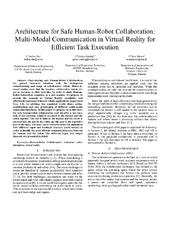Architecture for Safe Human-Robot Collaboration: Multi-Modal Communication in Virtual Reality for Efficient Task Execution
Permanent link
https://hdl.handle.net/10037/17487Date
2019-08-01Type
Peer reviewedChapter
Bokkapittel
Abstract
Task-sharing and Human-Robot Collaboration has gained increased attention with the widespread commissioning and usage of collaborative robots. However, recent studies show that the fenceless collaborative robots are not as harmless as they look like. In order to study Human-Robot Interaction scenarios, in a safe manner, we propose to execute the scenario in Virtual Reality simulation and afterwards implement it in real robotic applications (supervised from VR). In addition, this simulated world allows ad-hoc modifications and easy prototyping of different multi-modal communication forms. In this paper we propose an architecture for safe human-robot collaboration and describe a use-case: task of nut screwing, which is executed by the human and the robot together. The nut is hold by the human and the screw is screwed into the nut by the robot (as this part is the repetitive part of the task). The task can be executed in the VR simulation with different input and feedback channels (multi-modal) in order to identify the most efficient communication way between the human and the robot. The different input and output channels are presented in detail.
Publisher
IEEE (Institute of Electrical and Electronics Engineers)Citation
Shu, Sziebig, Pieters. Architecture for Safe Human-Robot Collaboration: Multi-Modal Communication in Virtual Reality for Efficient Task Execution. Proceedings of the IEEE International Symposium on Industrial Electronics. 2019:2297-2302Metadata
Show full item recordCollections
©2019 IEEE


 English
English norsk
norsk